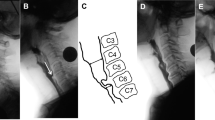Abstract
This study compared self-reported incidence and prevalence of dysphagia in inflammatory myopathy diseases with instrumental data from videofluoroscopy in a cohort of 18 patients with inflammatory myopathies (inclusion body myositis, polymyositis, and dermatomyositis). We found a high self-report of incidence of dysphagia and demonstrated that symptoms described by the patients follow a characteristic pattern. We conclude that there is a high incidence of dysphagia in all three of the inflammatory myopathies. Questions about swallowing should routinely be included in inflammatory myopathy patient examinations in order to appropriately refer patients for further investigation of their swallowing function and avoid the complications associated with dysphagia.
Similar content being viewed by others
References
Dalakas MC. Sporadic inclusion body myositis—diagnosis, pathogenesis and therapeutic strategies. Nat Clin Pract Neurol. 2006;2(8):437–47.
Oh TH, Brumfield KA, Hoskin TL, Stolp KA, Murray JA, Basford JR. Dysphagia in inflammatory myopathy: clinical characteristics, treatment strategies, and outcome in 62 patients. Mayo Clin Proc. 2007;82(4):441–7.
Mastaglia FL. Inflammatory muscle diseases. Neurol India. 2008;56(3):263–70.
Mastaglia FL, Phillips BA. Idiopathic inflammatory myopathies: epidemiology, classification and diagnostic criteria. Rheum Dis Clin North Am. 2002;28:723–41.
Eckberg O, Hamdy S, Woisard V, Wuttge-Hannig A, Ortega P. Social and psychological burden of dysphagia: its impact on diagnosis and treatment. Dysphagia. 2002;17(2):139–46.
Cox FM, Verschuuren JJ, Verbist BM, Niks EH, Wintzen AR, Badrising UA. Detecting dysphagia in inclusion body myositis. J Neurol. 2009;256:2009–13.
Williams RB, Grehan MJ, Hersch M, Andre J, Cook IJ. Biomechanics, diagnosis, and treatment outcome in inflammatory myopathy presenting as oropharyngeal dysphagia. Gut. 2003;42:471–8.
Needham M, James I, Corbett A, Day T, Christiansen F, Phillips B, Mastaglia FL. Sporadic inclusion body myositis: phenotypic variability and influence of HLA-DR3 in a cohort of 57 Australian cases. J Neurol Neurosurg Psychiatry. 2008;79:1056–60.
Needham M, Mastaglia FL. Inclusion body myositis: current pathogenetic concepts and diagnostic and therapeutic approaches. Lancet Neurol. 2007;6:620–31.
Liu LWC, Tarnopolsky M, Armstrong D. Injection of botulinum toxin A to the upper esophageal sphincter for oropharyngeal dysphagia in two patients with inclusion body myositis. Can J Gastroenterol. 2004;18(6):397–9.
Houser SM, Calabrese LH, Strome M. Dysphagia in patients with inclusion body myositis. Laryngoscope. 1998;108(7):1001–5.
Nagano H, Yoshifuku K, Kurono Y. Polymyositis with dysphagia treated with endoscopic balloon dilatation. Auris Nasas Larynx. 2009;36:705–8.
Parodi A, Caproni M, Marzano AV, De Simone C, La Placa M, Quaglini P, Veller Fornasa C, Zane C, Vaccaro M, Papini M, Fabbri P, Rebora A. Dermatomyositis in 132 patients with different clinical subtypes: cutaneous signs, constitutional symptoms and circulating antibodies. Acta Derm Venereol. 2002;82(1):48–51.
Na SJ, Kim SM, Sunwoo IN, Choi YC. Clinical characteristics and outcomes of juvenile and adult dermatomyositis. J Korean Med Sci. 2009;24(4):715–21.
Oh TH, Brumfield KA, Hoskin TL, Kasperbauer JL, Basford JR. Dysphagia in inclusion body myositis: clinical features, management and clinical outcomes. Am J Phys Med Rehabil. 2008;87(11):883–9.
Badrising UA, Maat-Schiemann ML, Houwelingen JC, van Doorn PA, van Duinen SG, van Engelen BG, Faber CG, Hoogendijk JE, de Jager AE, Koehler PJ, de Visser M, Verschuuren JJ, Wintzen AR. Inclusion body myositis: clinical features and clinical course of the disease in 64 patients. J Neurol. 2005;252(12):1448–54.
Wallace KL, Middleton S, Cook IJ. Development and validation of a self-report symptom inventory to assess the severity of oral-pharyngeal dysphagia. Gastroenterology. 2000;118(4):678–87.
Chen AY, Frankowski R, Bishop-Leone J, Hebert T, Leyk S, Lewin J, Goepfert H. The development and validation of a dysphagia-specific quality-of-life questionnaire for patients with head and neck cancer: The M.D. Anderson Dysphagia Inventory. Arch Otolaryngol Head Neck Surg. 2001;127(7):870–6.
Crary MA, Mann GD, Groher ME. Initial psychometric assessment of a functional oral intake scale for dysphagia in stroke patients. Arch Phys Med Rehabil. 2005;86(8):1516–29.
Logemann J. Role of the modified barium swallow in management of patients with dysphagia. Otolaryngol Head Neck Surg. 1997;116(3):335–8.
Nicosia MA, Robbins J. The usefulness of the line spread test as a measure of liquid consistency. Dysphagia. 2007;22(4):306–11.
National Institute of Neurological Disorders and Stroke (2010) Inflammatory myopathies fact sheet. http://www.ninds.nih.gov/disorders/inflammatory_myopathies/detail_inflammatory_myopathies.htm. Accessed 24 July 2010.
Green C, Pope C. Gender, psychosocial factors and the use of medical services: a longitudinal analysis. Soc Sci Med. 1999;48(10):1363–72.
Wilkins T, Gillies R, Thomas A, Wagner P. The prevalence of dysphagia in primary care patients. J Am Board Fam Med. 2007;20(2):144–55.
Acknowledgment
Funding granted by Sir Charles Gairdner Hospital Research Fund.
Author information
Authors and Affiliations
Corresponding author
Rights and permissions
About this article
Cite this article
Mulcahy, K.P., Langdon, P.C. & Mastaglia, F. Dysphagia in Inflammatory Myopathy: Self-report, Incidence, and Prevalence. Dysphagia 27, 64–69 (2012). https://doi.org/10.1007/s00455-011-9338-0
Received:
Accepted:
Published:
Issue Date:
DOI: https://doi.org/10.1007/s00455-011-9338-0




